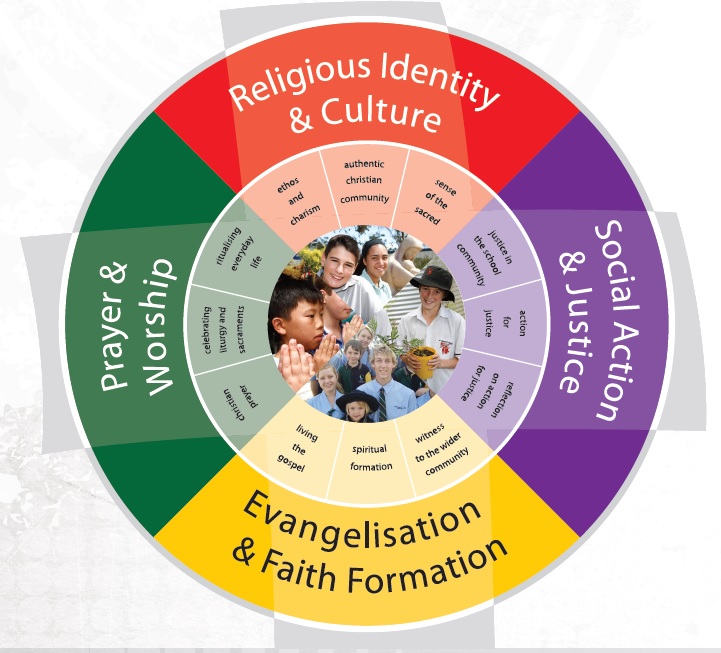The Vision for Religious Education as stated in the Religious Education Curriculum of Brisbane Catholic Education gives voice to what our hopes are for our students here at St Rita’s, Victoria Point in terms of their religious literacy and faith formation.
“The schools and colleges of the Archdiocese of Brisbane aspire to educate and form students who are challenged to live the gospel of Jesus Christ and who are literate in the Catholic and broader Christian tradition so that they might participate critically and authentically in faith contexts and wider society”

© Brisbane Catholic Education, Catholic Identity, 2021
Religious Education consists of two distinct but complementary dimensions, namely an educational dimension and a faith formation dimension.
The first dimension, most commonly referred to as the classroom teaching and learning of religion, is focussed on Religious Education as an educational activity. It utilises a range of teaching and learning processes and resources.
The second dimension, faith formation, is reflected in the religious life of the school, family and parish. The educational dimension and the faith formation dimension are inextricably linked. The classroom teaching of religion is one element in a complex web of experiences that have the potential to nurture the faith life of young people.
All classroom teachers are working from the Brisbane Catholic Education Religious Education Syllabus and Curriculum documents. Religious Education aims to "develop students' religious literacy in the light of the Catholic tradition, so that they may participate critically and effectively in the light of their faith communities and wider society" (A Syllabus for Religious Education for Catholic Schools).
© Brisbane Catholic Education, Catholic Identity, 2021
The curriculum involves four strands: Theses strands are interrelated and are taught in an integrated approach which are appropriate to the learning contexts of the class.
1. Sacred Texts
2. Beliefs
3. Church
4. Christian Life
At St Rita’s Victoria Point it is a requirement that a minimum of 2.5 hours per week of religion teaching is provided. This time is allocated in the way that best meets the needs of our students.

© Brisbane Catholic Education, Catholic Identity, 2021
The Religious Life of the School also comprises four interrelated components:
1. Religious Identity & Culture
2. Evangelisation & Faith Formation
3. Prayer and Worship
4. Social Action & Justice
Each of these components, while mutually reinforcing, provides a significant focus on a distinctive aspect of the religious life of our school and complements the teaching of religion within classroom. Of particular interest for St Rita's students', staff, parents and Parish community is the focus placed on the life of St Augustine and St Rita. By sharing in their stories our students and their families are encouraged to be people of Faith, Love, Service, Hope. Our commitment to responding to the Christian call defines our school – the framework for our responses to what happens in the wider community and the way we go about being members of St Rita's Catholic Primary School.
The shape of Religious Education within Brisbane Catholic Education has two dimensions, the classroom learning and teaching of religion and the religious life of the scho ol. These are two distinct but complementary dimensions described as 'teaching people religion and teaching people to be religious, in a particular way' (Moran, 1991).
St Rita's increasingly provides the introductory and developmental understanding and experience of Church for students and their families. This is supported when the school is a place where students and their families encounter the mission and outreach of the Church, especially through pastoral care and the experience of Catholic Christian community. In this community, such activities include:
- Commissioning masses
- Whole School Opening Masses
- Lenten and Holy Week Liturgies
- ANZAC day Memorials
- St Rita's Day Mass and celebrations
- Catholic Education Week Celebrations
- Connecting with neighbouring Catholic Schools to celebrate Mass (post covid)
- Class Buddy Masses
- Social Justice Activities
- Visits to the Church with Parish Associates
- Class Liturgies
Foundational to the shared work of teachers at St Rita's are the beliefs they have of the learners they serve. The BCE Learning and Teaching Framework (2012) explicitly articulates the beliefs and the responses that flow from these beliefs within schools in the Archdiocese.
- Every learner is created in the image and likeness of God and, inspired by the Spirit and responds with passion and creativity to life.
- Every learner seeks to find meaning in life and learning and, in the Catholic Christian Tradition, we find meaning in the person and teachings of Jesus to grow as pilgrim people.
- Every learner is a lifelong learner, with a desire to search for truth and do what is right; accountable for choices and responsible for actions.
- Every learner is in some respect, like all others, like some others, like no other and we respond creatively, flexibly and with a futures orientation to ensure dignity and justice for all.
- Every learner can achieve success in life and learning where diversity is valued and shared wisdom contributes to decision-making that enriches and enlivens our world.
SEE ALSO: Brisbane Catholic Education Catholic Identity >>